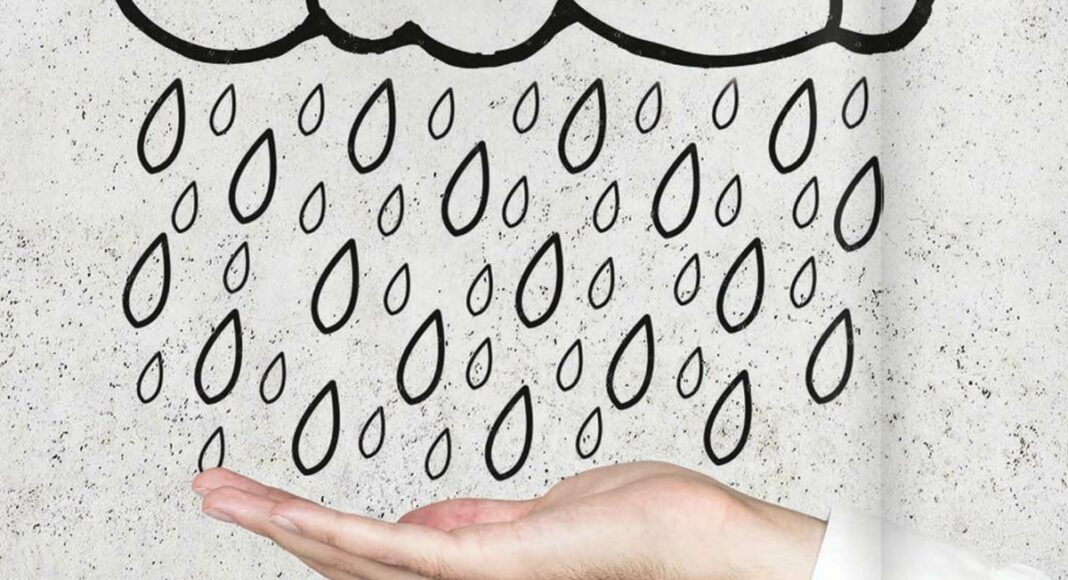With the rains of December and January, my yard—and most of Santa Cruz—is looking greener than it has in years. But now that we’ve got rain, what are we going to do with it?
Rainwater harvesting is a way to collect and store it instead of allowing it to run off. In a healthy ecosystem, rain percolates through soil to recharge streams, reservoirs and aquifers. Excessive runoff can create a whole suite of environmental issues, like stream-bank erosion, habitat degradation and flooding.
“The problems started when we paved so much land,” says Lydia Nielsen, owner of Rehydrate the Earth, a landscaping company that focuses on eliminating runoff.
One popular technique for rainwater harvesting is rain catchment—catching rainwater off of roofs in cisterns, and then using it to irrigate one’s yard. These cisterns can be small—about 50 gallons—or as big as wine barrel, and up to 10,000 gallons.
Golden Love, owner of Love’s Gardens, which builds water-neutral gardens, has worked extensively installing rain barrels, sometimes burying several of the larger tanks to store tens of thousands of gallons. On top of providing irrigation, these tanks have been successful in mitigating some large water issues, like depleted wells or saltwater intrusion. But, in his own yard, he has a smaller system that he uses to water annual vegetables. Even through the past years of drought, Love was able to maintain a vibrant garden with annual vegetables, flowers and fruit trees, thanks in part to his water catchment systems. Between 50-70 percent of home water use is generally for irrigation, meaning harvesting rainwater can improve water conservation dramatically.
Of course, these tanks can be pricey and not everyone wants to fill their yard with giant plastic barrels. In that case, another option for gardeners interested in capturing rainwater is passive rainwater harvesting, which involves sculpting the land to absorb more water—or, as enthusiasts like to say, “Slow it, spread it, sink it.”
Even through the past years of drought, Love was able to maintain a vibrant garden with annual vegetables, flowers and fruit trees, thanks in part to his water catchment systems.
A common technique for passive harvesting is to use infiltration basins. These are basins dug into the soil about 2-3 feet deep, then filled with wood chips or gravel. Water flows into the basins, where it has the opportunity to sink into the soil. Soil can hold up to three times its weight in water and supply steady irrigation to deeply rooted plants.
I met Nielsen at a site where she had installed three basins, placed where water typically pools during rain. Nielsen has interconnected the three basins so that if one fills up, it spills into the next. She designed a garden around the basins so that, eventually, the plants will be able to survive through the dry season without irrigation.

These basins produce quite a bit of soil, which Nielsen turned into another passive harvesting technique: a berm—essentially a long mound which stops and absorbs potential run off. Berms are often employed in conjunction with swales, which are trenches dug on a contour with the land’s slope as a place for water to sink in.
Even with the abundance of rain from El Niño, Californians should still lean toward water-wise gardening techniques such as rainwater harvesting, as the state has had one of the longest dry seasons on record. And with the uncertain future of climate change, we may have more drought ahead of us.
“I want this place to be lush,” says Love, who also uses passive water harvesting in his quest for water-neutral gardens. “We need to have habitat for the bees and the birds—and for humans, too.”
While sculpting land or installing rain barrels may be intimidating, Nielsen explains that it is not as hard as it sounds. “If it is just you and your friend and some shovels, how much trouble can you get into?” she asks. “But if you come in with a bulldozer and start digging out land, then, yes, you could get yourself into trouble.” She also mentions that anyone who lives on a sloped site should consult a professional. But for anyone else, as long as they start small, rainwater harvesting can be very simple.
There are plenty of resources out there. Nielsen and Love both teach classes, which you can find on their websites (RehydrateTheEarth.us and LovesGardens.com, respectively). Also the Resource Conservation District of Santa Cruz County has a free booklet, Slow it, Spread it, Sink it! A Homeowner’s Greening Stormwater Runoff. Nielsen also recommends the book Rainwater Harvesting for Dryland and Beyond by Brad Lancaster.
Rainwater harvesting is just one technique in a suite of water-wise options. Another common one is installing a graywater system, which redirects water draining from showers or laundry for irrigation. And, of course, choosing the right plants is of the utmost importance. Love focuses on low-water, food-producing perennials such as fruit trees. He was able to water his dozens of fruit trees through the drought with just the water from his laundry.
There is also much to be said for clever design. Love’s backyard has an outdoor shower next to his fruit trees. “I take my shower out here, and it waters the plum tree,” he says.













